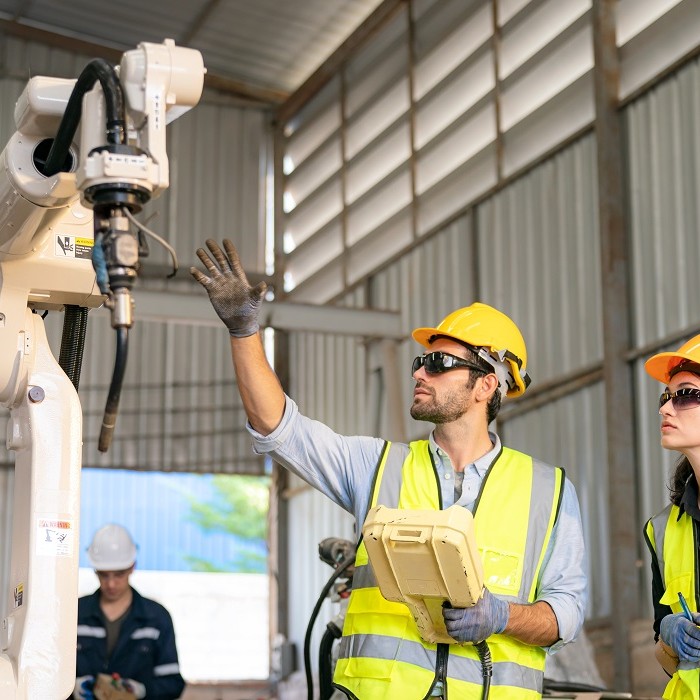In September 2022, standing in front of a groundbreaking of the $20 billion Intel semiconductor chip factory outside of Columbus, Ohio, U.S. President Joe Biden made a bold declaration about the future of America’s economy.
“It’s time to bury the label ‘Rust Belt’ and call it … the ‘Silicon Heartland,’” Biden said.
Is the Rust Belt Still Relevant?
The Rust Belt — encompassing natural resource-rich areas of the upper Midwest through central New York that was once a thriving industrial manufacturing center — has long tried to pivot its economy from a defunct past toward a more prosperous future. That is, toward a future in the growing tech sector.
Indeed, Rust Belt cities over the course of the last decade have invested heavily in creating tech-based economies by courting startups like Duolingo in Pittsburgh and StockX in Detroit.
Most recently, Rust Belt revitalization has seen an investment boom with the support of the CHIPS and Science Act, which is aimed at bringing high-tech manufacturing back to the United States. In fact, several chipmakers, including Intel and Micron, have already announced plans to build new plants in the Rust Belt. And those investments are just the tip of the iceberg.
In Ohio, the federal government is investing up to $750 million in creating a sustainable polymers tech hub.
“Ohio is a natural fit to host a regional technology hub,” said Ohio Senator Sherrod Brown. “As the historic rubber capital of the world, Akron is the ideal location for the future of sustainable polymers, to produce the domestic rubber and plastics of the 21st century. This investment will ensure that Ohio will lead in the technologies of the future, with Akron at the center of sustainable materials innovation.”
LG and Honda’s partnership to build a $4.4 billion dollar battery plant in Ohio will also be key to the Rust Belt’s revitalization. As construction on the factory nears completion, the project is expected to create 2,200 new jobs.
Uber is testing its self-driving technology on public roadways in western Pennsylvania.
The region is also well-positioned to foster a future of innovation, including capitalizing on the dramatic rise of artificial intelligence. The Midwest is home to 20 universities ranked among the top 200 best in the world, helping it to jumpstart the next generation of talent and ideas.
Cities throughout the region are well-suited to take on an expanded role as a part of Industry 4.0, but will need a continued focus on workforce development — geared toward people already living there — to truly become the “Silicon Heartland.”
“The billions of dollars we’ve invested to create an infrastructure for tech growth is incredible,” Pittsburgh Mayor Ed Gainey said at a workforce conference. “You can see the growth … but the reality is, if it’s not helping the people that’s been here forever, there’s going to be a divide — and we want to eliminate the divide as we brand ourselves as a tech city.”
Pittsburgh is now home to over a hundred start-ups in AI and robotics alone.
What Midwest Tech Industry Jobs Could Mean for the Rust Belt
But can the Rust Belt truly transform to the Tech Belt?
That’s the central question in a new book by tech journalist Rebecca Fannin, titled Silicon Heartland: Transforming the Midwest from Rust Belt to Tech Belt. In it, Fannin returns to her hometown of Lancaster, Ohio, to report on how tech ecosystems — of talent, venture capital, workforce development, universities, and R&D — are shifting midsized heartland cities toward tech-based economies.
“We are seeing new technologies replace old steel mills … such as AI and robotics and autonomous driving,” Fannin said in an interview with her publisher.
“I think the Rust Belt can compete with China’s Tech Belt, and it’s on its way. We’re seeing many developments, such as venture capital pouring in from the coasts — from New York and Boston and San Francisco. We’re seeing a lot of new talent develop.”
Talent development is vital to the Rust Belt’s transformation. So much so that regional leaders want to develop the region’s existing talent while accelerating upward mobility for Black, Indigenous, and people of color who have traditionally been underrepresented in the field.
In Gary, Indiana, for example, the industry-led nonprofit TechPoint wants to create 41,000 jobs for Black Hoosiers by 2030. Pursuant to their goal, TechPoint and its community partners recently received a $300,000 grant that they’ll use to create a tech-focused, adult apprenticeship program for low-income, central Indiana Black men and women.
Workforce development and diversity initiatives are key themes not only in Indiana but across the region. As cities replace once-booming industries like automobile manufacturing and steel mills, there’s a need to reskill and upskill workers for the tech-based “New Economy.”
There are “countless” people who have the ability to succeed in the growing Rust Belt tech industry, TechPoint founder and CEO Emil Ekiyor said in an interview on TechPoint’s website. But many of them don’t have the resources or relationships to access tech-sector jobs.
By participating in programs like those created by TechPoint, companies will “open the door to opportunities that can create generational change while helping to fill some of their most-needed roles right away and for years to come,” Ekiyor said.
Why Did Industry Leave the Rust Belt in the First Place?
The nation’s industrial heartland began to face intense international competition by the mid-20th century. As other countries recovered from the Second World War, industries that were once the hallmark of the United States economy like steelmaking, coal mining or automobile manufacturing, were facing immense pricing pressures from overseas. With the rise in globalization, developing nations offered an even cheaper labor market for companies to tap into. At first, the competition forced lower wages and prices, but it eventually shuddered factories and eliminated millions of jobs throughout the American Midwest.
Upskilling in Upstate New York
Syracuse, New York, once thrived as a manufacturing hub. Like many Rust Belt cities, however, jobs left for cheaper labor overseas. Now, thanks to an infusion of tech infrastructure, it’s on the verge of a new job boom and economic revitalization.
Syracuse has made deep investments in creating a tech-based economy courtesy of its Syracuse Surge initiative, the goal of which is positioning Syracuse as one of America’s “smartest cities” and a global leader in the New Economy. Through partnerships, Syracuse Surge invests in reskilling and upskilling Central New York residents for careers in coding, cybersecurity, and high-tech manufacturing. Since the program launched in 2019, it has reskilled and upskilled more than 1,000 city residents for careers in tech.
Syracuse Surge also laid the foundation to attract the largest single investment in New York State history. In October 2022, semiconductor chip manufacturer Micron announced it would spend up to $100 billion building a mega-complex of computer chip plants in Syracuse’s northern suburbs. The investment will create up to 9,000 Rust Belt jobs over the next 20 years.
How Long Will Revitalization Take?
“We’re taking the long view here,” Syracuse Mayor Ben Walsh said during his annual State of the City address.
“As we’re going into the Fourth Industrial Revolution that is going to be based on connectivity and the Internet of Things, we’re making a technology infrastructure investment that puts us ahead of every other city in the country in advancing those technologies. It puts us in a once-in-a-generation position to surge ahead to not only compete in the Fourth Industrial Revolution, but to thrive in it.”
Maribel Arce, director of Greater Syracuse Works (GSW), has seen the shift firsthand and is working to make a more equitable workforce for all.
“Syracuse is currently experiencing a resurgence, attracting new industries and employers. Greater Syracuse Works’ role is to advocate for this growth to be inclusive and equitable,” Arce said in an interview with The Forecast. “For this to happen, there is much work to do. We need to address the barriers that underserved populations face when entering the workforce.”
Greater Syracuse Works is a network of 30 member organizations that include community-based organizations, educational institutions and business associations that work together to remove barriers to employment for Syracuse’s most vulnerable populations.
“We are very excited to see all the changes coming to the greater Syracuse region. GSW is working with its network of members to ensure we have done all that is possible for city residents to be ready for this monumental shift,” Arce said.
“Opportunities will abound for those who have the qualifications to access them. Not all jobs will be for engineers in the technology industry. We also believe that there will be a growth in demand for goods and services in other industries, as well.”
Through ongoing community conversations, GSW is using a “bottom-up” approach that is informed by direct service staff trying to prepare vulnerable populations for meaningful careers and economic success. It’s working to build wraparound services that can support people as they embark on their journey to enter and thrive in the New Economy.
“The rise of Syracuse as one of the leading places in the nation for technology investment is going to the next level,” Mayor Walsh said in a press release.
“Micron’s commitment to build a ‘mega-complex’ in Onondaga County brings historic energy to the Syracuse Surge, our strategy for inclusive growth in the New Economy.”
In Syracuse and across the Rust Belt, higher job growth creates an opportunity for upskilling and reskilling the existing workforce. Doing so can ensure a more equitable and prosperous future for a region that for too long has been remembered for what it was instead of what it might yet become.
This is an updated version of the article published on April 26, 2023.
https://www.nutanix.com/theforecastbynutanix/news/tech-industry-jobs-key-to-rust-belt-revitalization
Editor’s note: Learn how Nutanix hybrid multicloud IT technologies can benefit state and local government agencies.
Jacob Gedetsis is a contributing writer. His work has appeared in The Kansas City Star, The Post Standard and The Plain Dealer, among others. Find him on Twitter at @JacobGedetsis.
© 2024 Nutanix, Inc. All rights reserved. For additional legal information, please go here.








